Blyth, Nottinghamshire (†Southwell) C.15
Doom
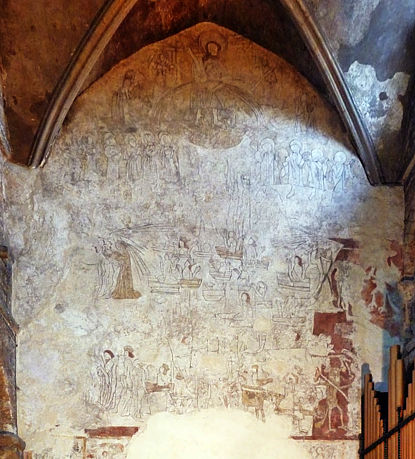
Along with a much-mutilated Passion Cycle on the wall below it, this is the only wall painting yet to come to light in Nottinghamshire, and it is a particularly fine example with some uncommon features.
The upper part of the painting is hard to capture on film, but shown at the right below is a detail of the Judging Christ, seated as usual on a rainbow. The figure looks clumsy, because the painter has struggled to show the rainbow as it appears in the natural world – a frontally presented broad, banded arc.
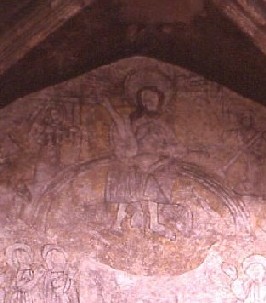
Seating Christ convincingly on this was always a problem for medieval painters, which is why so many Dooms give the impression that Christ stands in front of the rainbow, which arcs behind him. Here the painter has tried to solve the problem by foreshortening the lower half of Christ’s body and skewing it very markedly to the left (onlooker’s). The attempt does not work, but it does demonstrate how painters tried to deal with this intractable problem of perspective.
At the left, angels present Instruments of the Passion, rather blurred in this photograph, and at the right an angel blows a trumpet.
Below this level is one of the details that make this Doom remarkable, the row of Apostles standing with hands raised and heads turned towards Christ Below at the left are the five remaining on the left – a sixth has effectively gone. They are shown in half-profile, all turned towards Christ, with hands raised and held apart in the traditional intercessory manner.

The other Apostles are at the right, and four of them are clear. These stand more frontally, their hands raised higher, in what is probably the most ancient supplicatory posture of all, and one usually confined to much earlier art. There are no truly similar examples on this site, although the Apostles at Kempley come close, as do those at Houghton-on-the-Hill, where they hold scrolls. In the case of Blyth, I think it is unlikely that the Apostles are intended as actual co-assessors at the Judgement; their function is more likely to be that of straightforward intercession, as in the much commoner case of the Virgin Mary and John the Baptist.
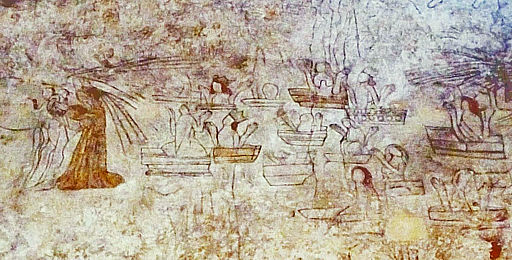
In the incident-packed centre of the painting, however, the details (right) are very typical of later Dooms of the 15th century. The dead rise, most of them from small, boat-shaped tombs. Many crowned heads feature and one king or queen on the right has an elaborately decorated sarcophagus. All raise their hands in wonder and almost all face left, where an angel in a dark gold robe and prominent wings greets a group of the Saved.
Opposite this Angel, on the right hand side of the painting, devils go about their tasks among the Damned, who are being driven into Hell by a second angel, probably St Michael (below left). He wears an unusual robe, white with dark bordering giving a crossover effect, his right hand is raised and if he held a sword or other weapon, it is difficult to see among the feathers of his wings now. At the right, two or three damned souls move towards a partly obscured red devil with three-toed claws.
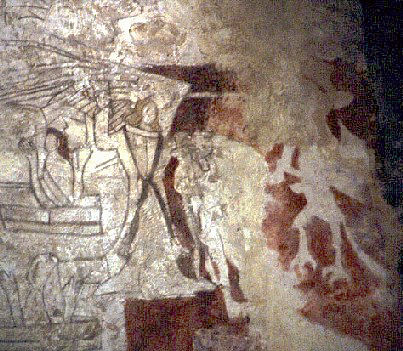
The booklet on sale in the church mentions the Devil with a yellow sack on his back containing two figures, one with a mitre, but I cannot identify this with any certainty on the wall. Also mentioned is a wheelbarrow, which would link the painting with the Dooms at Bacton and Yaxley. There is certainly something very roughly resembling a wheelbarrow or some similar contrivance beside a large yellow devil (possibly Satan himself) at the furthest bottom right of the painting, (below, right). But I am very uncertain about this object, which to judge by its shape and the position of its wheel, would be a problem to push around. Medieval painters usually painted familiar artefacts like this much more recognisably, as in the two examples mentioned above.
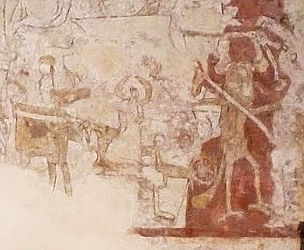
There was once an even greater wealth of detail than now appears in the Blyth Doom, and the most interesting aspect of it is the combining of very old iconographical details such as the Apostles with the kind of imaginative flourishes – cauldrons, (possible) wheelbarrows, realistic late medieval tombs, the manipulation of Christ’s figure on the rainbow – that had reached their fullest development towards the end of the 15th century.
The Passion Cycle mentioned above, fragmentary though it is, will be here soon. There is also a very fine painted screen at Blyth, and most of the figures of saints on it – among them St Agatha undergoing her gruesome martyrdom – are still very clear.